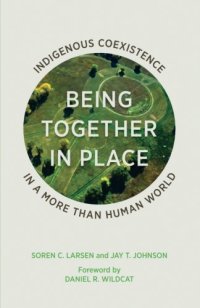
Ebook: Being Together in Place: Indigenous Coexistence in a More Than Human World
Author: Soren C. Larsen Jay T. Johnson
- Tags: Native American, Americas, History, Human Geography, Social Sciences, Politics & Social Sciences, Native American Studies, Specific Demographics, Social Sciences, Politics & Social Sciences, Colonialism & Post-Colonialism, Specific Topics, Politics & Government, Politics & Social Sciences, History, Africa, Ancient, Asia, Europe, Latin America, Middle East, Military, United States, Humanities, New Used & Rental Textbooks, Specialty Boutique, Geography, Social Sciences, New Used & Rental Textbooks, Specialty Boutique, Politi
- Year: 2017
- Publisher: Univ Of Minnesota Press
- Edition: 1
- Language: English
- pdf
Being Together in Place explores the landscapes that convene Native and non-Native people into sustained and difficult negotiations over their radically different interests and concerns. Grounded in three sites—the Cheslatta-Carrier traditional territory in British Columbia; the Wakarusa Wetlands in northeastern Kansas; and the Waitangi Treaty Grounds in Aotearoa/New Zealand—this book highlights the challenging, tentative, and provisional work of coexistence around such contested spaces as wetlands, treaty grounds, fishing spots, recreation areas, cemeteries, heritage trails, and traditional village sites. At these sites, activists learn how to articulate and defend their intrinsic and life-supportive ways of being, particularly to those who are intent on damaging or destroying these places.
Using ethnographic research and a geographic perspective, Soren C. Larsen and Jay T. Johnson show how the communities in these regions challenge the power relations that structure the ongoing (post)colonial encounter in liberal democratic settler-states. Emerging from their conversations with activists was a distinctive sense that the places for which they cared had agency, a “call” that pulled them into dialogue, relationships, and action with human and nonhuman others. This being-together-in-place, they find, speaks in a powerful way to the vitalities of coexistence: where humans and nonhumans are working to decolonize their relationships; where reciprocal guardianship is being stitched back together in new and unanticipated ways; and where a new kind of “place thinking” is emerging on the borders of colonial power.